Abstract
A monoclonal antibody, M522, reacting with human monocytes, neutrophils and a proportion of non-adherent PBL in a pattern similar to OKM-1 and anti-Mo-1, and precipitating a dimer of MW 165,000 and 100,000 from neutrophils, was shown to react with C3 at an epitope localized on the alpha-chain of C3. F(ab)2-fragments of M522 stimulate the respiratory burst of neutrophils and monocytes. M522 differs from two monoclonal antibodies against the Mo-1 molecule with respect to the capacity to inhibit the binding of sheep erythrocytes coated with different C3-fragments to C-receptor carrying cells. It inhibited the binding of H-coated particles to B-lymphoid cells and precipitated a 50,000 MW molecule from RAJI cells and tonsil lymphocytes. The results obtained suggest an antigenic relationship between the alpha-chain of C3, the heavy chain of a membrane molecule involved in neutrophil/monocyte activation, and a B-cell molecule of MW 50,000.
Full text
PDF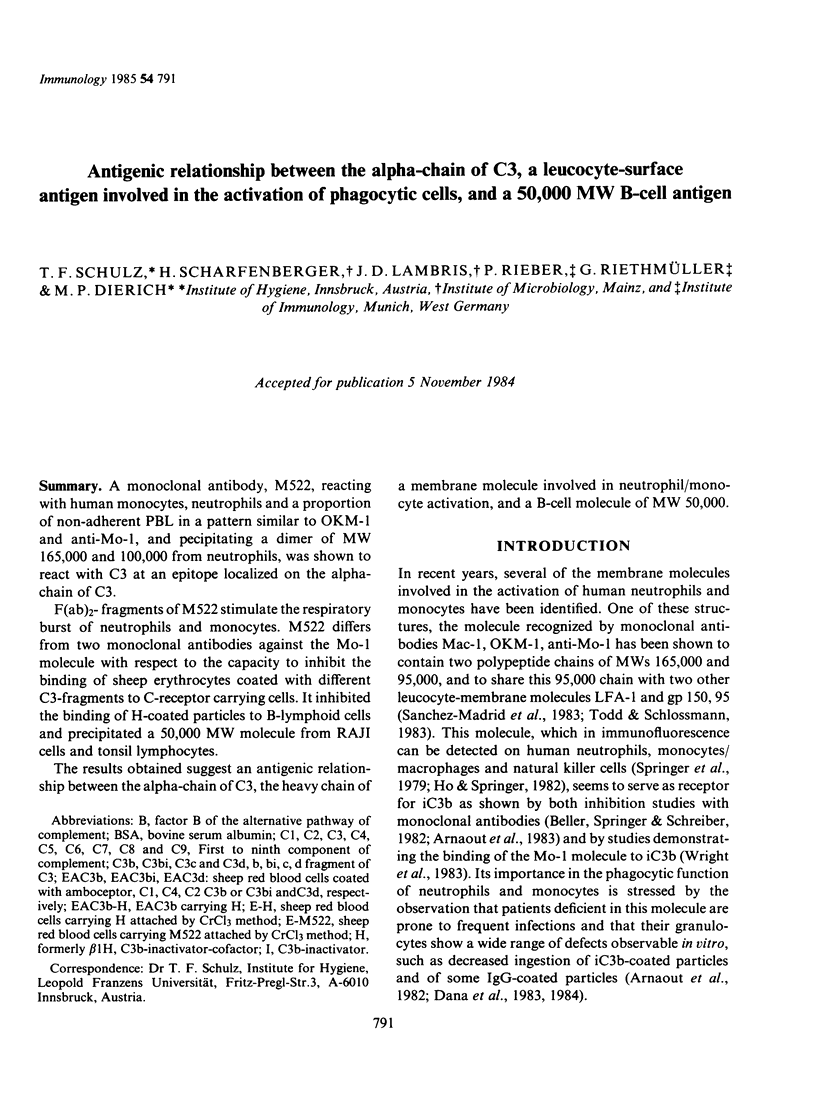
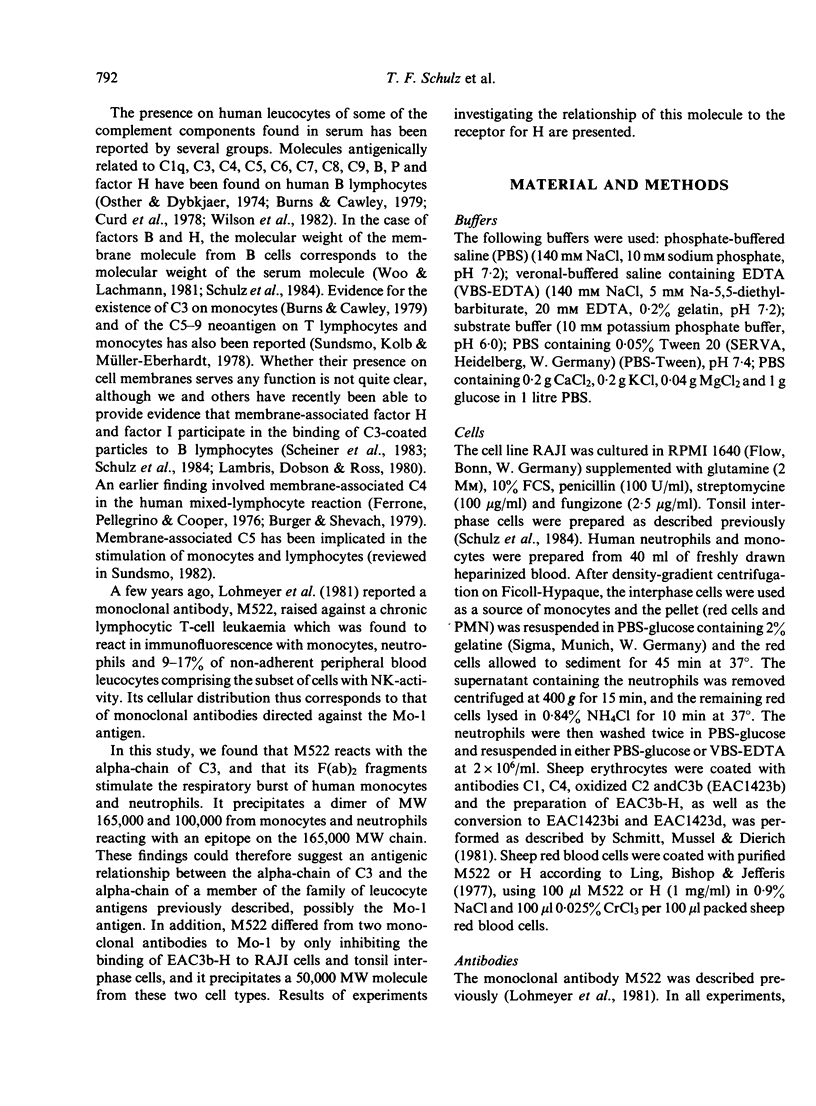

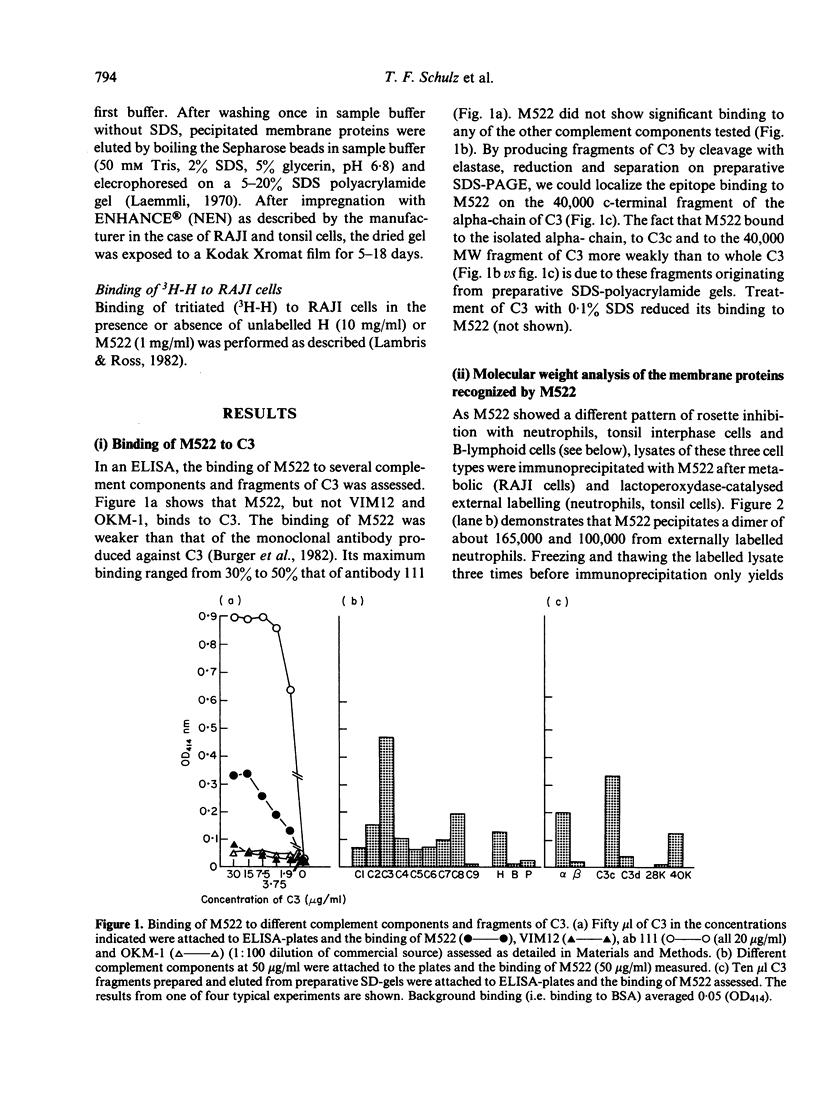
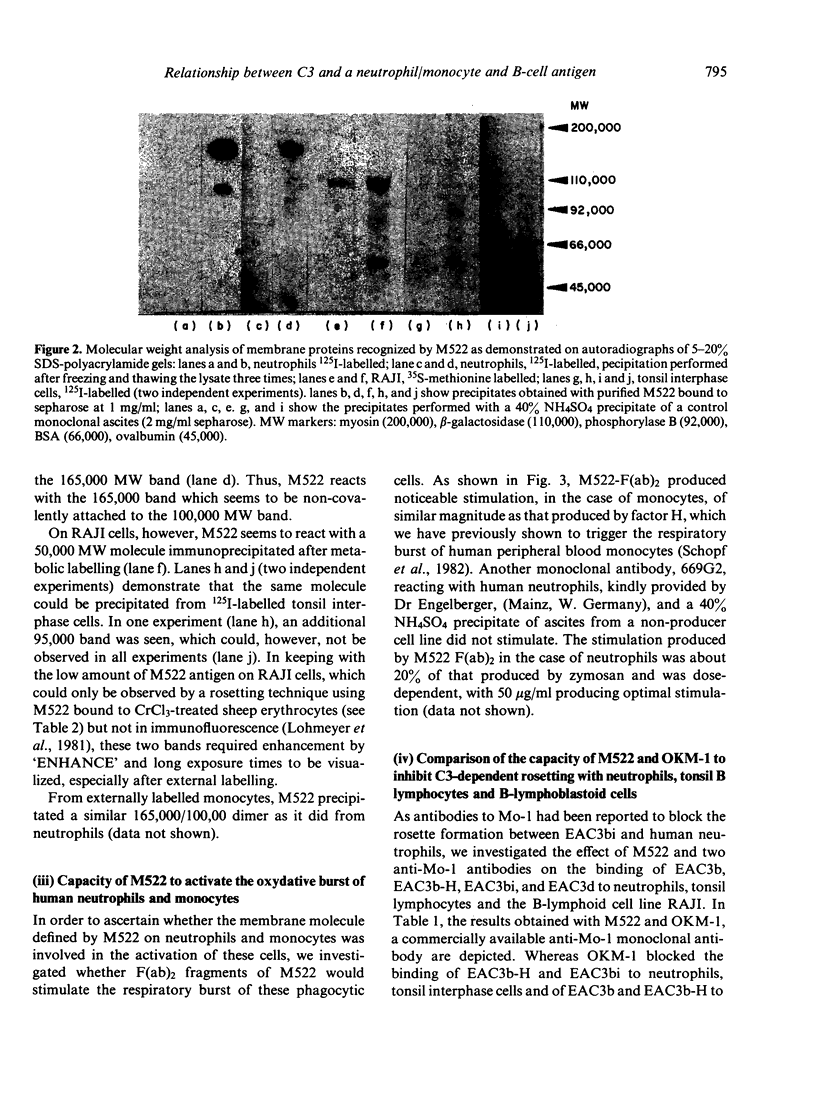
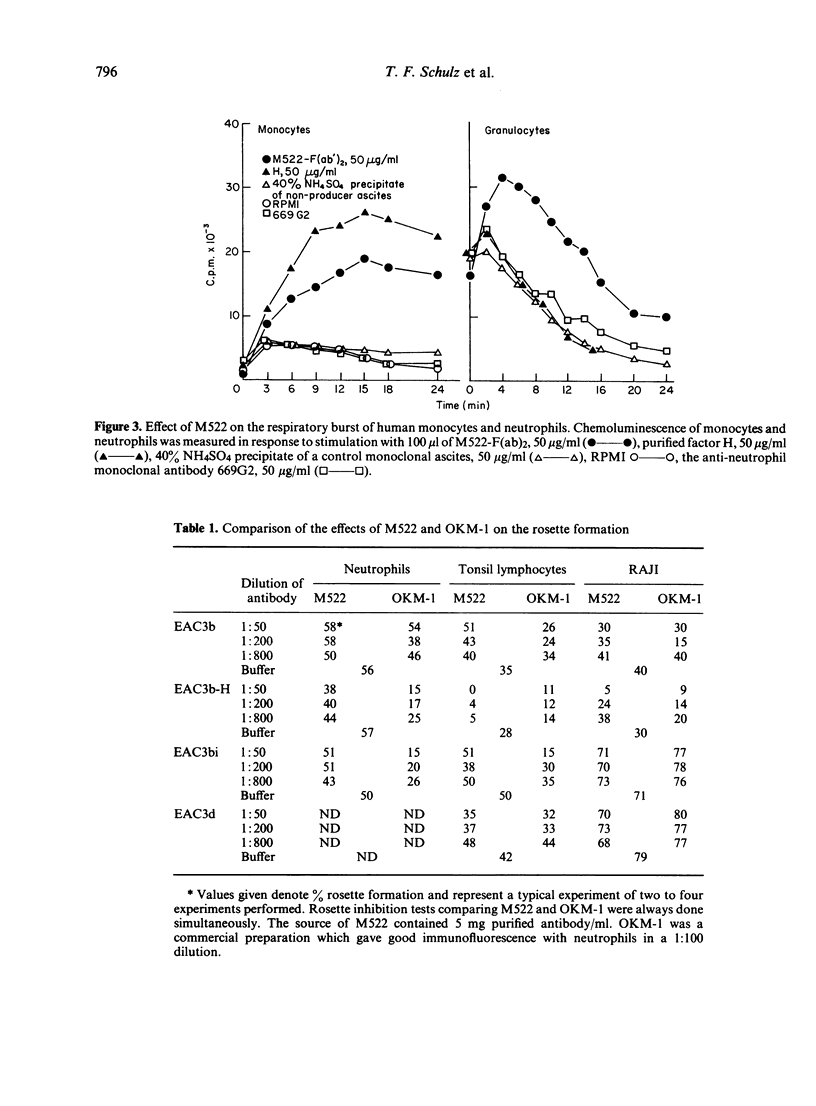
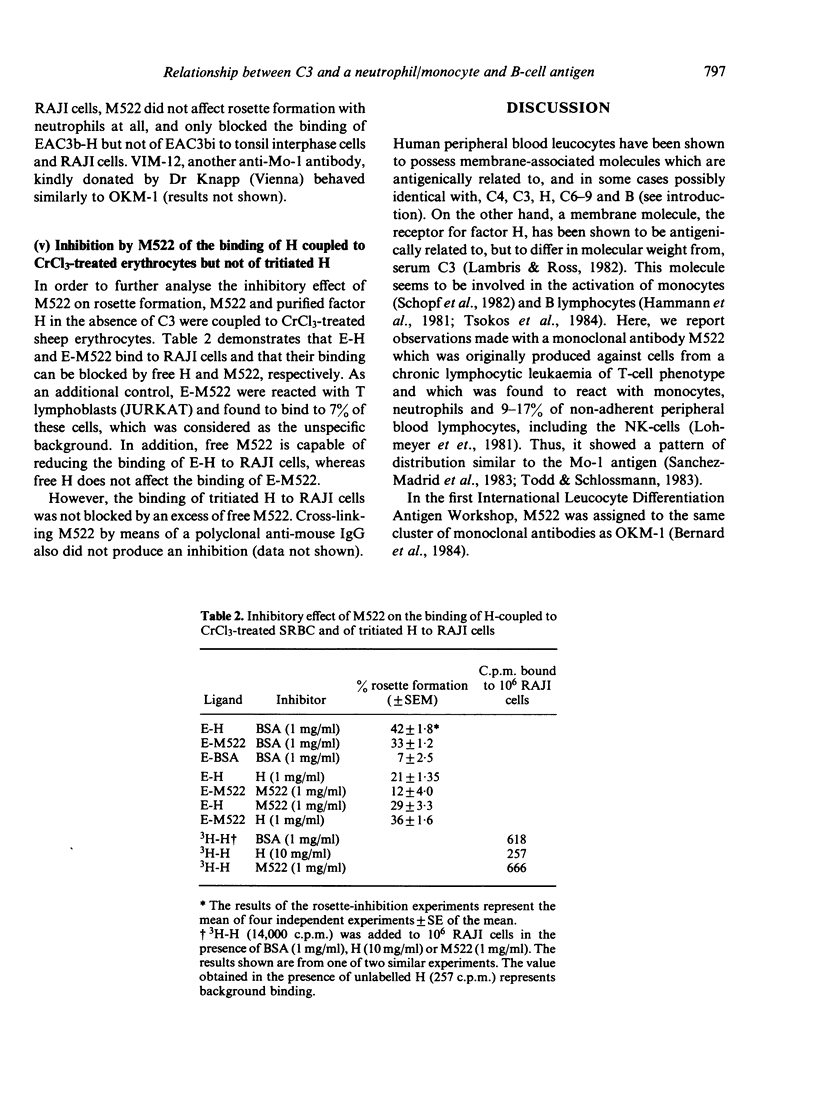
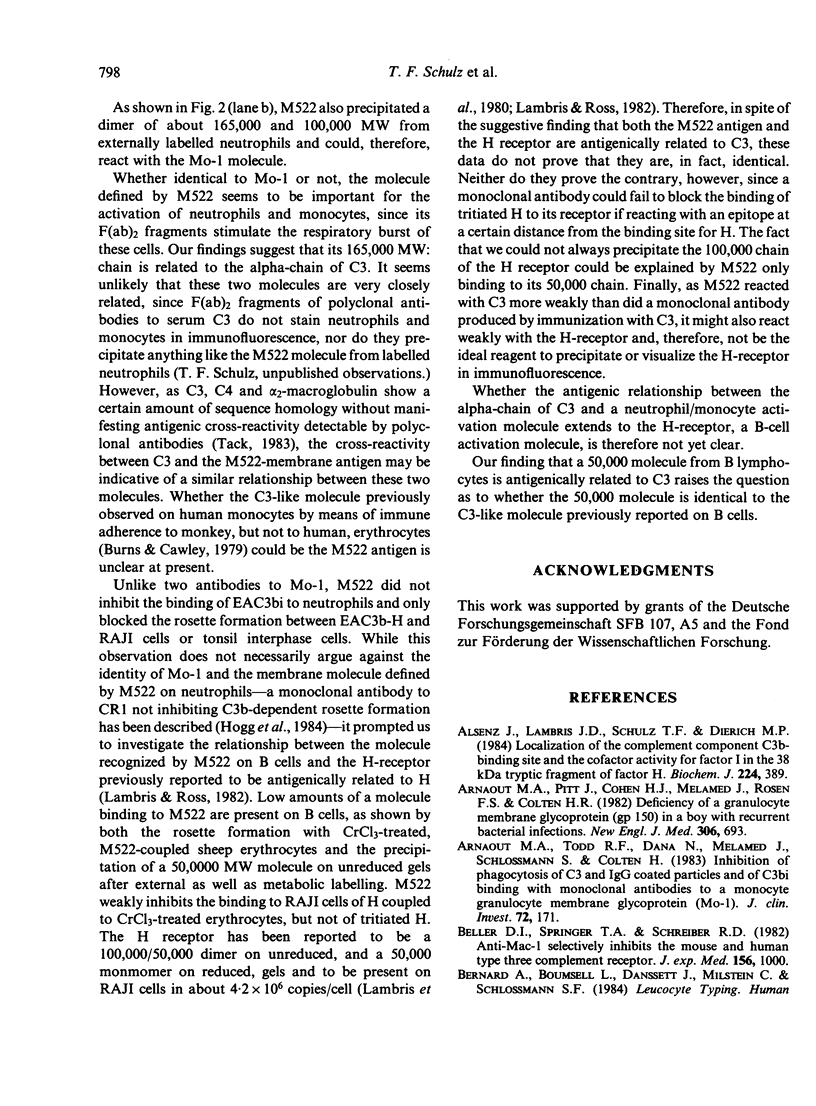
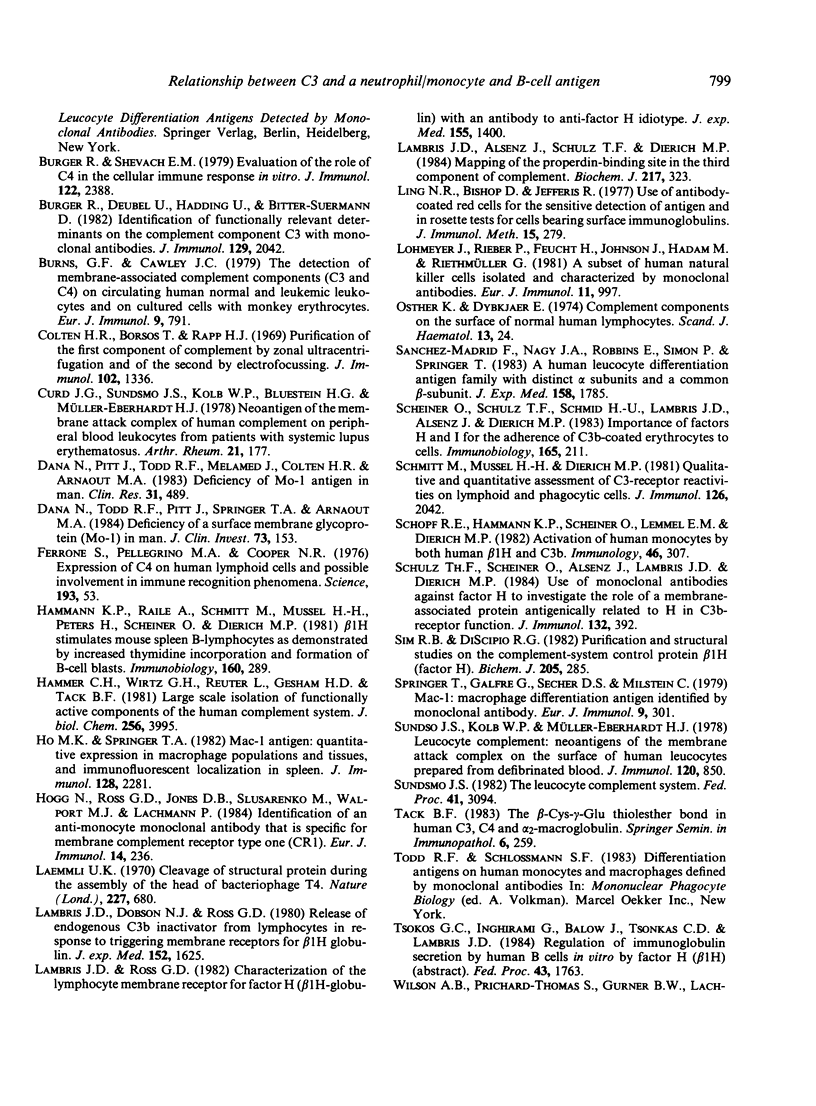
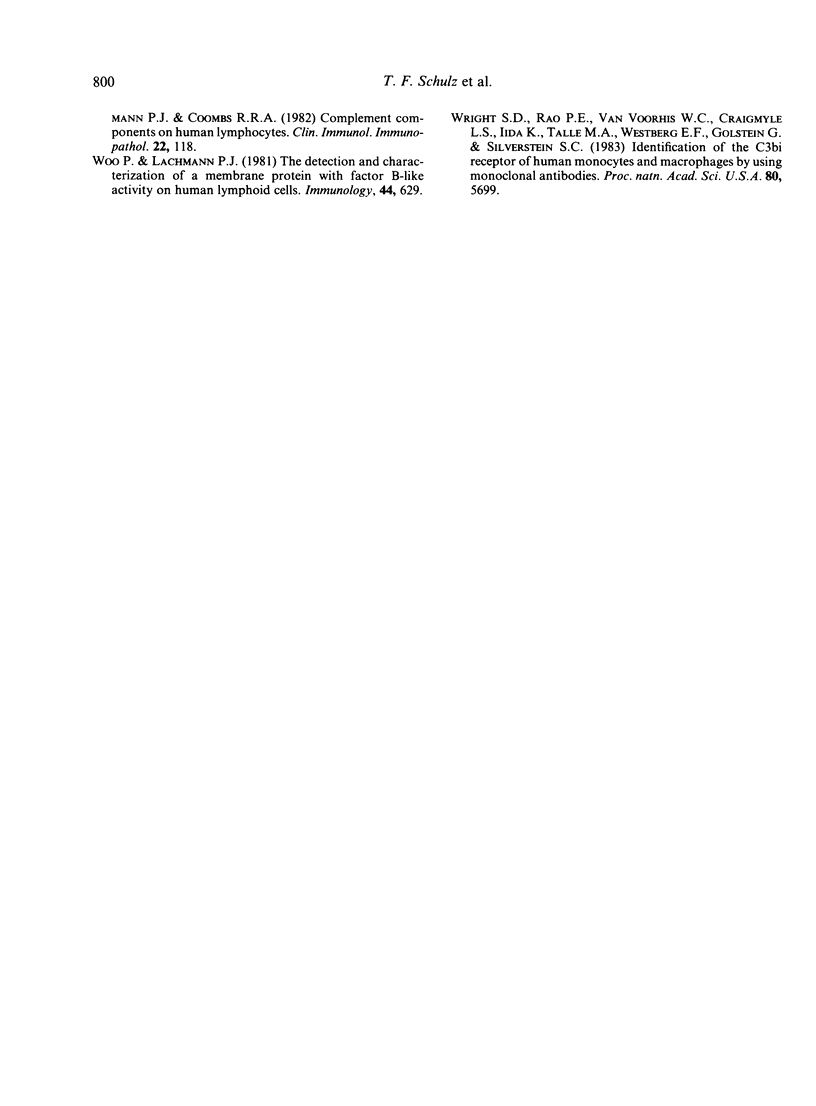
Images in this article
Selected References
These references are in PubMed. This may not be the complete list of references from this article.
- Alsenz J., Lambris J. D., Schulz T. F., Dierich M. P. Localization of the complement-component-C3b-binding site and the cofactor activity for factor I in the 38kDa tryptic fragment of factor H. Biochem J. 1984 Dec 1;224(2):389–398. doi: 10.1042/bj2240389. [DOI] [PMC free article] [PubMed] [Google Scholar]
- Arnaout M. A., Pitt J., Cohen H. J., Melamed J., Rosen F. S., Colten H. R. Deficiency of a granulocyte-membrane glycoprotein (gp150) in a boy with recurrent bacterial infections. N Engl J Med. 1982 Mar 25;306(12):693–699. doi: 10.1056/NEJM198203253061201. [DOI] [PubMed] [Google Scholar]
- Arnaout M. A., Todd R. F., 3rd, Dana N., Melamed J., Schlossman S. F., Colten H. R. Inhibition of phagocytosis of complement C3- or immunoglobulin G-coated particles and of C3bi binding by monoclonal antibodies to a monocyte-granulocyte membrane glycoprotein (Mol). J Clin Invest. 1983 Jul;72(1):171–179. doi: 10.1172/JCI110955. [DOI] [PMC free article] [PubMed] [Google Scholar]
- Beller D. I., Springer T. A., Schreiber R. D. Anti-Mac-1 selectively inhibits the mouse and human type three complement receptor. J Exp Med. 1982 Oct 1;156(4):1000–1009. doi: 10.1084/jem.156.4.1000. [DOI] [PMC free article] [PubMed] [Google Scholar]
- Burger R., Deubel U., Hadding U., Bitter-Suermann D. Identification of functionally relevant determinants on the complement component C3 with monoclonal antibodies. J Immunol. 1982 Nov;129(5):2042–2050. [PubMed] [Google Scholar]
- Burger R., Shevach E. M. Evaluation of the role of C4 in the cellular immune response in vitro. J Immunol. 1979 Jun;122(6):2388–2394. [PubMed] [Google Scholar]
- Burns G. F., Cawley J. C. The detection of membrane-associated complement components (C 3 and C 4) on circulating human normal and leukemic leukocytes and on cultured cells with monkey erythrocytes. Eur J Immunol. 1979 Oct;9(10):791–796. doi: 10.1002/eji.1830091009. [DOI] [PubMed] [Google Scholar]
- Curd J. G., Sundsmo J. S., Kolb W. P., Bluestein H. G., Müller-Eberhard H. J. Neoantigen of the membrane attack complex of human complement: Occurrence on peripheral blood leukocytes from patients with systemic lupus erythematosus. Arthritis Rheum. 1978 Mar;21(2):177–182. doi: 10.1002/art.1780210201. [DOI] [PubMed] [Google Scholar]
- Dana N., Todd R. F., 3rd, Pitt J., Springer T. A., Arnaout M. A. Deficiency of a surface membrane glycoprotein (Mo1) in man. J Clin Invest. 1984 Jan;73(1):153–159. doi: 10.1172/JCI111186. [DOI] [PMC free article] [PubMed] [Google Scholar]
- Hammann K. P., Raile A., Schmitt M., Mussel H. H., Peters H., Scheiner O., Dierich M. P. beta 1H stimulates mouse-spleen B lymphocytes as demonstrated by increased thymidine incorporation and formation of B cell blasts. Immunobiology. 1981;160(3-4):289–301. doi: 10.1016/s0171-2985(81)80055-1. [DOI] [PubMed] [Google Scholar]
- Hammer C. H., Wirtz G. H., Renfer L., Gresham H. D., Tack B. F. Large scale isolation of functionally active components of the human complement system. J Biol Chem. 1981 Apr 25;256(8):3995–4006. [PubMed] [Google Scholar]
- Ho M. K., Springer T. A. Mac-1 antigen: quantitative expression in macrophage populations and tissues, and immunofluorescent localization in spleen. J Immunol. 1982 May;128(5):2281–2286. [PubMed] [Google Scholar]
- Hogg N., Ross G. D., Jones D. B., Slusarenko M., Walport M. J., Lachmann P. J. Identification of an anti-monocyte monoclonal antibody that is specific for membrane complement receptor type one (CR1). Eur J Immunol. 1984 Mar;14(3):236–243. doi: 10.1002/eji.1830140307. [DOI] [PubMed] [Google Scholar]
- Laemmli U. K. Cleavage of structural proteins during the assembly of the head of bacteriophage T4. Nature. 1970 Aug 15;227(5259):680–685. doi: 10.1038/227680a0. [DOI] [PubMed] [Google Scholar]
- Lambris J. D., Alsenz J., Schulz T. F., Dierich M. P. Mapping of the properdin-binding site in the third component of complement. Biochem J. 1984 Jan 1;217(1):323–326. doi: 10.1042/bj2170323. [DOI] [PMC free article] [PubMed] [Google Scholar]
- Lambris J. D., Dobson N. J., Ross G. D. Release of endogenous C3b inactivator from lymphocytes in response to triggering membrane receptors for beta 1H globulin. J Exp Med. 1980 Dec 1;152(6):1625–1644. doi: 10.1084/jem.152.6.1625. [DOI] [PMC free article] [PubMed] [Google Scholar]
- Lambris J. D., Ross G. D. Characterization of the lymphocyte membrane receptor for factor H (beta 1H-globulin) with an antibody to anti-factor H idiotype. J Exp Med. 1982 May 1;155(5):1400–1411. doi: 10.1084/jem.155.5.1400. [DOI] [PMC free article] [PubMed] [Google Scholar]
- Ling N. R., Bishop S., Jefferis Use of antibody-coated red cells for the sensitive detection of antigen and in rosette tests for cells bearing surface immunoglobulins. J Immunol Methods. 1977;15(3):279–289. doi: 10.1016/0022-1759(77)90065-5. [DOI] [PubMed] [Google Scholar]
- Lohmeyer J., Rieber P., Feucht H., Johnson J., Hadam M., Riethmüller G. A subset of human cells isolated and characterized by monoclonal antibodies. Eur J Immunol. 1981 Dec;11(12):997–1001. doi: 10.1002/eji.1830111209. [DOI] [PubMed] [Google Scholar]
- Osther K., Dybkjaer E. Complement components on the surface of normal human lymphocytes. Scand J Haematol. 1974;13(1):24–32. doi: 10.1111/j.1600-0609.1974.tb00231.x. [DOI] [PubMed] [Google Scholar]
- Sanchez-Madrid F., Nagy J. A., Robbins E., Simon P., Springer T. A. A human leukocyte differentiation antigen family with distinct alpha-subunits and a common beta-subunit: the lymphocyte function-associated antigen (LFA-1), the C3bi complement receptor (OKM1/Mac-1), and the p150,95 molecule. J Exp Med. 1983 Dec 1;158(6):1785–1803. doi: 10.1084/jem.158.6.1785. [DOI] [PMC free article] [PubMed] [Google Scholar]
- Scheiner O., Schulz T. F., Schmid H. U., Lambris J. D., Alsenz J., Dierich M. P. Importance of factors H and I for the adherence of C3b-coated erythrocytes to cells. Immunobiology. 1983 Aug;165(2):211–224. doi: 10.1016/S0171-2985(83)80061-8. [DOI] [PubMed] [Google Scholar]
- Schmitt M., Mussel H. H., Dierich M. P. Qualitative and quantitative assessment of C3-receptor reactivities on lymphoid and phagocytic cells. J Immunol. 1981 May;126(5):2042–2047. [PubMed] [Google Scholar]
- Schopf R. E., Hammann K. P., Scheiner O., Lemmel E. M., Dierich M. P. Activation of human monocytes by both human beta 1H and C3b. Immunology. 1982 Jun;46(2):307–312. [PMC free article] [PubMed] [Google Scholar]
- Schulz T. F., Scheiner O., Alsenz J., Lambris J. D., Dierich M. P. Use of monoclonal antibodies against factor H to investigate the role of a membrane-associated protein antigenically related to H in C3b-receptor function. J Immunol. 1984 Jan;132(1):392–398. [PubMed] [Google Scholar]
- Sim R. B., DiScipio R. G. Purification and structural studies on the complement-system control protein beta 1H (Factor H). Biochem J. 1982 Aug 1;205(2):285–293. doi: 10.1042/bj2050285. [DOI] [PMC free article] [PubMed] [Google Scholar]
- Springer T., Galfré G., Secher D. S., Milstein C. Mac-1: a macrophage differentiation antigen identified by monoclonal antibody. Eur J Immunol. 1979 Apr;9(4):301–306. doi: 10.1002/eji.1830090410. [DOI] [PubMed] [Google Scholar]
- Sundsmo J. S., Kolb W. P., Müller-Eberhard H. J. Leukocyte complement: neoantigens of the membrane attack complex on the surface of human leukocytes prepared from defibrinated blood. J Immunol. 1978 Mar;120(3):850–854. [PubMed] [Google Scholar]
- Sundsmo J. S. The leukocyte complement system. Fed Proc. 1982 Dec;41(14):3094–3098. [PubMed] [Google Scholar]
- Tack B. F. The beta-Cys-gamma-Glu thiolester bond in human C3, C4, and alpha 2-macroglobulin. Springer Semin Immunopathol. 1983;6(4):259–282. doi: 10.1007/BF02116276. [DOI] [PubMed] [Google Scholar]
- Wilson A. B., Prichard-Thomas S., Gurner B. W., Lachmann P. J., Coombs R. R. Complement components on human lymphocytes. Clin Immunol Immunopathol. 1982 Jan;22(1):118–127. doi: 10.1016/0090-1229(82)90028-9. [DOI] [PubMed] [Google Scholar]
- Woo P., Lachmann P. J. The detection and characterization of a membrane protein with Factor B-like activity on human lymphoid cells. Immunology. 1981 Nov;44(3):629–639. [PMC free article] [PubMed] [Google Scholar]
- Wright S. D., Rao P. E., Van Voorhis W. C., Craigmyle L. S., Iida K., Talle M. A., Westberg E. F., Goldstein G., Silverstein S. C. Identification of the C3bi receptor of human monocytes and macrophages by using monoclonal antibodies. Proc Natl Acad Sci U S A. 1983 Sep;80(18):5699–5703. doi: 10.1073/pnas.80.18.5699. [DOI] [PMC free article] [PubMed] [Google Scholar]



